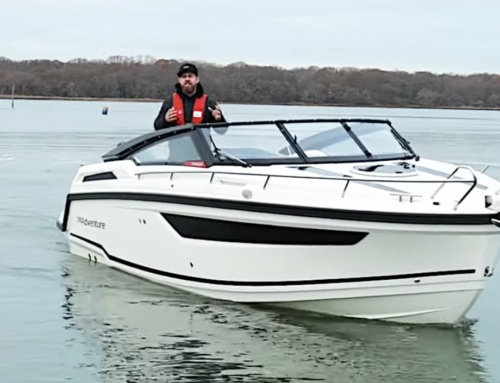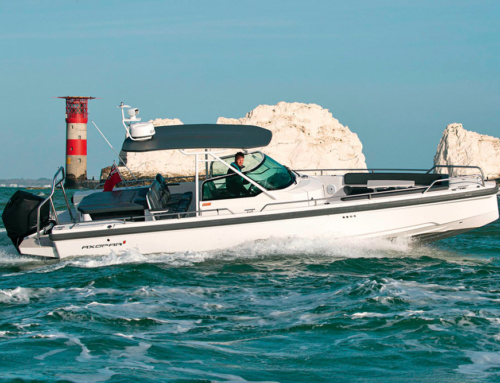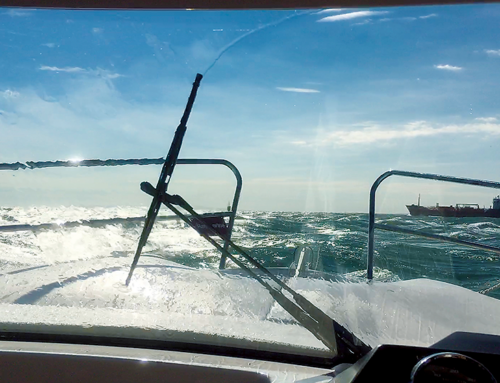Bilge diving and sorting out some odd jobs – Alex Whittaker is living the dream …
Once again, I am sleeping aboard. This time I am working through a few easy jobs. The first is to replenish the ship’s spirits locker. Now the Bayliner’s booze locker, like me, is notoriously shallow, and not too tall. This means that a standard 70cl bottle of malt will not fit – an astounding oversight by the Bayliner design team, probably based on too much blind reliance on CAD systems. However, all is not lost. Last year my painstaking market research indicated that triangular 37.5cl Glenfiddich bottles are ideal. They fit well. They do not get in the way of the locker’s door catch. Most importantly, they stay put at 40 knots. Furthermore, I can now report that there is a new contender in the ‘boat-friendly’ licensed-victuals stakes – the 37.5cl-sized bottle of Penderyn single malt, which fits almost as well.
Bilge pump trauma
The most important task on my pre-season jobs list was to do some bilge ratting. I needed to ascertain why the Bayliner’s manual rear bilge pump had suddenly given up the ghost. You see, I switched on a few days ago and there was no comforting whirr beneath the back deck. Now I have always adored the calming ritual of switching on the bilge pump and just watching the water flow. I always stand there mesmerised until the last drop is ejected. Efficient bilge pumps are essential for marina contentment, and with the deep midwinter still upon us, reliable bilge pumping is doubly important.
Now it so happens that my beloved but affordable Bayliner is a ‘factory boat’ – a mass-produced American item, and not a luxury hand-built one-off piece of Euro exotica. Cieras were (and still are) sold in their thousands. This means that my sweet little 245 was built down to a price. The good news is that there are actually two factory-fitted bilge pumps aboard, one under the cabin sole and one under the MerCruiser V8. Bearing in mind my Bayliner’s modest price point in the market, both these factory pumps are simple, inexpensive, manual jobs. Readers may remember that a couple of seasons ago I also fitted a Sahara 1100 automatic bilge pump as a backup to these two manuals. All seemed well with my ‘belt-and-braces bilge policy’ until the rear manual unit let go. I set about fettling it.
I ran the bilge blower for about 10 minutes, with the hatch up, in case there were any fumes under the back deck. Then I climbed down into the Bayliner’s rather tight engine compartment. There is precious little room around the V8. In fact, there is also a lot of ‘domestic’ kit packed in down there. This includes the H&C water system, shore power kit and mains battery charger. After much discomfort, I managed to suss out the layout of the existing Johnson pump. Significantly, it was a cartridge type, with a removable business end. The cartridge has two big plastic ears, like a wing nut. You can press and twist out the cartridge in seconds to clear any debris, or even replace an unserviceable unit. Note that it is most important not to lose the large rubber O-ring. Very conveniently, this clever Johnson design leaves its lower plastic strum-box-cum-strainer screwed down to pads in the boat hull lay-up. Just as well, since this factory installation employs the inevitable sturdy Jubilee clip secured to the output hose, with the joint sealed with mastic. All hideously inaccessible. I was glad I did not need to disturb the strum box, and the output tubing was in a very unhappy position. Unfortunately, even when crouched, the pump lay about half a yard below my feet. I had a dreadful time attempting to disentangle the pump wires from the wiring loom. However, the killer issue was the feeder wiring to the pump, which had been pegged out of the way of the Merc’s flywheel in the factory. This had been accomplished by a couple of distressingly awkwardly placed cable ties. These were screwed to a low, wooden, glassed cross member. There was no point removing the duff unit just yet until I sourced a new pump, so I took a photo of the semi-removed unserviceable cartridge with my ancient but handy iPhone 4. This gave me the cartridge model number. Next, I stoked up the iPad on the marina Wi-Fi, and hit the Internet.
US import
I could not track down any Johnson 1000-gallons-per-hour cartridges in the UK. One UK dealer did have a complete pump in stock at over £90. Frankly, this seemed a bit much for a product that felt like a 40-quid item. I passed and looked further afield. On the Internet, I had trouble finding a cartridge insert with exactly the same model number. I soon realised that a similar part number with an extra digit was actually the same device. Finally, on eBay UK, I ordered the new cartridge from onlineboatparts@gmail.com in the USA. I can thoroughly recommend their prompt and excellent service. It is ideal if, like me, you are running an American boat in this country. The cartridge cost $39.95. Adding postage and packing (paid in America) brought the total amount to $57.29. At the time, this was around £42. eBay UK’s ‘onlineboatparts013’, based in the USA, said the pump would arrive by 28th December 2017. In fact, it arrived in the UK a whole two weeks earlier. Great service.
Two days after it landed I got a card through my door from the UK post office. This informed me that the parcel had not been delivered since a customs payment was due. (It was actually a VAT payment.) Inconveniently, I had to travel 6 miles to the next town to pick up the parcel, and pay the VAT. I had to take my passport and a utilities bill – what a pantomime! The passport ID proved OK, but then I read the details of the post office bill and found I had to pay an extra £16.73! There was no excise duty or import duty to pay, just £8.73 for VAT. What was the additional eight quid for, I wondered? When I looked closer, the post office wanted me to stump up a mysterious ‘Royal Mail international handling fee’ on this US postage-paid parcel. Never mind the round trip of 12 miles in my own car. I was understandably feeling mutinous, and well and truly conned.
Fit it
Desperate men demand desperate measures. Between the wintry showers, I made a couple of radical decisions. I was never going to be able to unscrew those offending cable ties that deep in the bilge. Also, the more I loosened a wretched cable tie, the more it fouled the V8’s flywheel. Did Bayliner fit that blessed bilge pump before they fitted the blinking engine? Aaaiiiee! I decided on drastic action. My earlier multimeter tests indicated that power was present at the pump. Thus the old pump was definitely ‘kaput’. So I did what I would normally never do and snipped off its wires hard near the motor. I then pulled said power wires gently through the cable ties. Crouched and jammed uncomfortably against the cold engine block, this gave me just about enough length of cable to almost get get it in my hands. It was still fingertip stuff, but I thought I might just manage. After decades of bilge diving and making power connections in frustratingly confined spaces on my boats, I have long learned the wisdom of prefabrication. In other words, plan your difficult wiring and connectors in a comfortable workplace – in this case, fabricating a ‘quick-fit’ wiring loom while sitting at the cabin table. Thus I prepared the new pump cartridge cable ends to fit a 15A chocolate block connector. In this way it would easily mate with the existing newly cut feed wire. I do have smaller block connectors, but it is easier to standardise on the larger ones. I could then snap the pump cartridge home into its strum box, and easily make off the chocolate block power connections with my stubby screwdriver. I would then simply screw the choc block connector onto a convenient place, about 3 feet above any possible bilge water. I could later encapsulate the chocolate block connector in heat-shrink tubing. This all went well until it came to the supposedly simple task of baring back the recently cut feed cable down in the bilge. It was still maddeningly low in the bowels of the boat – much too low for me to wield my side cutters one-handed. I then remembered my trusty but cheap cable-stripping tool. Niftily, you align this along the length of a cable and its articulated jaws automatically strip back the insulation for you. You are left with a gleaming bare conductor. You can work the tool with one hand too.
Anyway, wielded one-handed and wedged hard against the Merc, this worked a treat. Once all the wiring and new cartridge were jury rigged, the dash aft bilge switch was thrown … Nothing! The dash switch was illuminated to show it was working, and I checked that no fuses had blown. Laboriously I chased the positive power rail all the way back to the battery with my multimeter – it all checked out. This involved tracing the power via the master 12v fuse box and the rubber-domed waterproof circuit breakers under the dash. Even the master 12v circuit breaker in the waterproof deck locker had not tripped.
By now I was puzzled, cold and more than a little wet from the last shower. I went down below to the cabin for a cup of one-shot sachet Nescafé. I warmed up and had a good think. I concluded it must be a bad earth. Both power rails were certainly there at the pump when I had first metered the job, so I must have disturbed something when pulling the wires through the cable ties. Where the pump’s earth strap had worked loose was anybody’s guess – somewhere in that complex wiring loom, no doubt. I did not have a handy length of cable aboard to check my ‘bad earth’ hypothesis. If there had been, I would have just connected the earth side (0 volts) of the pump to the negative (-) terminal of the battery, and switched on. If the pump ran, this would indicate that I had successfully directly ‘looped out’ the bad earth return from the pump to the battery. With no jumper cable handy to test this idea, all I could find in my bosun’s bag was a £1.99 car accessory shop ‘live’ circuit checker. This is no more than a length of curly cable fitted with an earth crock at one end and a metal 12v probe at the other. The probe has a bulb that glows when it detects +12 volts. I used this device as a temporary earth jumper lead, and lo: the new pump whizzed into life. Relief! Later, it was then a simple matter to splice in a proper new heavy earth strap back to the battery. They key point was that the pump was back in service, and all would be well. I felt that glow you get from being a bit self-sufficient and actually fixing a small fault on your boat.
Tide clock
I am an Englishman who came to Wales many years ago on missionary work. Since I am lucky enough to be self-employed, I mostly work from home. My boat is moored about half an hour away. Now then, it would be nice to know the state of the tide at the marina every time I felt the need to skive off work. Of course, I do have tide tables on paper, plus those on websites accessed via my desktop Mac computer. I also have a number of tidal apps on my ancient iPhone 4. However, a ‘constantly reading’ tide clock on the wall would be very nice.
Tidal movement
A tide clock tracks the moon’s apparent motion around the earth. As most mariners already know, the pull of the moon’s gravity on the earth’s oceans affects the tides. Now it so happens that my marina at Deganwy takes exactly 24 hours and 50.5 minutes to rotate under the moon, not the strict 24 hours of our normal domestic clock cycle. This means that a tide clock has to work to a different celestial rhythm. In practice, simple tide clocks usually divide the day into two roughly six-hour periods. The face can then show the state of the tide, including rising or falling. Some can even show springs and neaps. Mind you, I do not require ultimate precision from my wall-mounted tide clock. The meteorologically corrected, caesium-synchronised, online website predictors are much better at that. However, just a casual glance at a pretty brass dial to show me where we are in the tidal cycle would be a very useful tool for maximising my skiving potential.
Being canny, before the recent festive period I let it be known to my family that the ‘Ancient Mariner’ would look favourably upon a brass tide clock. Anyway, my son tracked one down, and I duly received it from Mrs Whittaker as a very welcome gift. It is handsome and has a battery-powered movement. My model is a Coastguard and Time & Tide Clock from DayClox Ltd. (I am not supposed to know, but it cost about 30 quid – quite a bit less than similar offerings from the big mail-order chandlers.) It has a fine pressed brass case, not the much more expensive cast-and-turned heavy brass type. However, I like it. It has a normal clock movement plus an extra hand for the state of the tide. Thus it shows the rise and fall of the tide, and, most usefully, the number of hours I have to fill in at work before I can skive off to the boat. My new tide clock has a special 168-hour cyclical movement that takes seven days to complete a single cycle. It only ticks once every 60 seconds. The tide clock has to be set to the local high tide of your desired port at full moon. I have yet to do this, since the cycle has not come around. (If I was cleverer, I could work backwards from my Reed’s Almanac.) I like the simple surface mounting via three screws, and the easy AA battery power – a doddle to fit to a cabin bulkhead or a domestic wall. Very boaty too. In this regard, my new tide clock is going to be a winner. I am currently pondering whether to buy another for the boat. A final key point for all us lazy savages: the brass on my example looks to be varnished, so it should never need polishing.
Marina wildlife
The other night, having dined well, Mrs Whittaker and I were rolling back along the pontoon from the Deganwy Quay Hotel. It is only about 50 paces from the marina bridge. Walking along the home pontoon, out of the corner of my eye, I thought I saw a black shape crossing a moored RIB – maybe the shadow of a gull on night shift passing overhead. Next morning I was making the tea and toast. I was staring idly out of the cabin window when I definitely saw a very smooth shape slip into the water. It was about 50 yards away. It had left the cover of the very RIB we had passed the night before. The thing was, this was not a local cormorant. It was sleek, black and furry. The clincher was its four legs! As luck would have it, I had my camera with me. Leaving my toast, I slipped out onto the back deck. From under the canvas, I poked the lens towards the sighting. About five minutes later, the cover on the RIB twitched again. This time I could see two black eyes, and a definitely rodent-like snout. However, again, the animal was exceedingly sleek. If anything, it looked like a weasel on steroids. At that moment the first animal returned. It swam up and hauled itself out of the marina, and then clambered onto one of the floating plastic jet ski docks. This cheeky chappie looked me straight in the eye, completely unafraid. Definitely a mink. Not a species native to Wales, and perhaps a descendant of those animals escaped, or liberated, from 1950s mink farms. To my eyes, these examples did not appear to be brown, as such ‘feralised’ mink are supposed to appear. They looked, well, sleek and black. I know the mink has the reputation of being a fearsome predator, and I certainly wondered about the damage those teeth and sharp claws might do to our boats. Up until that point, I had no idea that mink liked salt water. Half of me enjoyed the idea of having exotic wildlife in the marina. However, my other more cautious half feared their impact on local wildlife. Not to mention my boat cover.
Epilogue
As I write this, the days are lengthening. My boater’s mind is already turning to spring and its many important tasks up on the hard. Stay tuned.
About the Author:
Alex Whittaker is PBR’s Mediterranean cruising correspondent and Pilot Guide scribbler. He bought his first powerboat in 1974, so it is paid for by now. His current craft is a Bayliner 245 Ciera sport cruiser, fitted with a handy MerCruiser 350 Mag V8. Alex keeps the boat at Deganwy Marina on the Conwy River in North Wales. He always buys his round …













